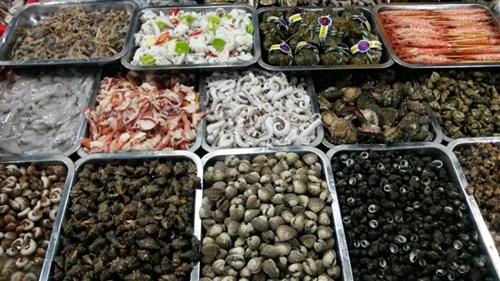Children eat too much harm
In recent years, with the continuous improvement of living standards, many parents often spend money to buy various kinds of seafood for their children or take their children out to eat seafood in order to provide more nutrition for their children. Many kinds of seafood, rich in nutrition, is one of many people's home cooking. But what should children pay attention to when they eat seafood? What should be the best way to eat it?
Children have a lot of good seafood

Seafood refers to fish, shrimp, crab, shellfish and other animal foods from the ocean. They are not only diverse, tasty, but also very nutritious and suitable for children's health. The protein content of marine fish and shrimp is very high, and the amino acid composition is similar to the human body and is a very good quality protein. Most of the fats in seafood are unsaturated fatty acids, especially deep-sea fish also contain certain amounts of eicosapentaenoic acid (EPA) and docosahexaenoic acid (DHA). These fatty acids help to promote children. The growth of the brain and body. Oyster is the food with the most abundant zinc in trace elements. There are more iodine in sea cucumbers and mussels. The two trace elements, zinc and iodine, play an indispensable role in the process of growth and development.
Eating seafood is not always better
Although seafood is delicious and nutritious, it is good for children's growth and development, but it is not always better, that is to say, every time you pay attention to the right amount, you can not eat it. Seafoods grown in the sea, especially offshore products, are contaminated by many pathogenic microorganisms and often contain parahaemolytic Vibrio which can cause food poisoning. Some seafood also carry Vibrio cholerae, a pathogen causing virulent infectious diseases. Therefore, when processing seafood, be sure to boil and cook thoroughly. When cooking seafood, it must be hot enough to prevent external cooking. In particular, common seafood such as sashimi, raw sea urchin, drunk crab, and drunk shrimp should be eaten less, and it is best not to eat it. Even if this kind of food is very fresh, without the cooking process, pathogenic bacteria or parasite infections and allergies may occur. Children who are in a period of growth and development, the body's various physiological functions are still not perfect, immunity and resistance are relatively weak, if not pay attention to the health of eating seafood, it is more likely to cause adverse consequences. At the same time, eat less (or do not eat) fish with small crosses and forks. Although this fish has a delicate meat texture and a sweet taste, due to the children's poor ability to handle fishbone, they are accidentally injured when they accidentally get stuck in the throat with tiny fishbone.
Do not eat fruit immediately after eating seafood
As fish, shrimp, crab and other seafood are rich in protein and calcium and other nutrients, and fruits often contain a certain amount of tannic acid (common tannic acid content is more grapes, pomegranates, hawthorn, persimmon, etc.), tannic acid into the gastrointestinal After the passage, it will not only precipitate and coagulate with protein, but also affect the body's full absorption of protein. It can also combine with calcium in seafood to form non-digestible compounds, which not only reduces the nutritional value of seafood, but also leads to digestion. Bad, it can also stimulate the gastrointestinal tract, causing abdominal pain, diarrhea, nausea, vomiting and other symptoms. This is why many people, especially children, have abdominal discomfort or diarrhea after eating seafood and eating a lot of fruit. So how long after eating seafood can you eat fruit? Experts suggest that after a seafood meal, it is advisable to eat fruit for at least 2 hours (because food is emptying in the stomach for about 2 to 3 hours).
Children need to eat seafood less spicy
First, children's kidney function has not been perfected, and it is not possible to eliminate the extra sodium that remains in the body. Therefore, eating too salty can cause the seeds of kidney disease and hypertension to be blamed in the future. Furthermore, studies have shown that excessive salt intake in children also affects the body's absorption of zinc, which is also the cause of upper respiratory tract infections. Therefore, children's diet (including eating seafood) is mainly light, not too salty, in order to reduce the excessive intake of salt. Second, children's digestive function is relatively poor, and seafood is a high-protein food, and eating too much fat can easily cause indigestion, abdominal pain, diarrhea and other symptoms. Third, many people like to add spicy food when they eat seafood. However, children's digestive tract mucosa is delicate, too spicy food is a great stimulus to it, easily causing harm.
There are some children who are allergic to seafood. It is recommended that they should take a small amount on the first try to see if they are seafood allergies. In addition, because seafood products in Chinese medicine are attributed to cold, windy things, so eat cold foods on weekdays, diarrhea and gastrointestinal sensitivity of children should eat less to avoid abdominal pain, diarrhea, bad symptoms. Harmful metal elements are easily deposited on the head of seafood, so children try not to eat shrimp heads and fish heads.
Fungi, a large class of chlorophyll - free, can not carry out photosynthesis, heterotrophic lower class of plants. These include bacteria, slime molds and fungi. Their common characteristics are: the plant body has no differentiation of roots, stems and leaves, does not contain chlorophyll and other photosynthetic pigments (except a few photosynthetic bacteria), can not carry out photosynthesis, saprophytic life or parasitic life, that is, heterotrophic life. Most of the reproductive organs are single-cell structures, and the zygotes do not develop into embryos.
Ganoderma Lucidum Extract,Lion's Mane mushroom Extract,Chaga Mushroom Extract
Xi'an Double H Health Technology Co., Ltd , https://www.xahnhcj.com